|
|
ARTHROPODS:
Insects»
Spiders»
Centipedes»
Millipedes»
Sowbugs»
Harvestmen»
Mites
& Ticks»
Scorpions»
Identification
Tips»
About
the Critter Files»
Links» |
|
|
|
| Swallowtails
are butterflies in the subfamily Papilioninae within the family
Papilionidae. Most of the swallowtails in Kentucky are large and
easy to recognize, with bold black-and-yellow or black-and-blue
patterns. Unlike butterflies in many other families (including Nymphalidae
and Daniadae), swallowtails do not have tiny front legs.
Many swallowtails look
very similar, so it is important to closely examine field guides
for accurate identification. Detailed pictures of swallowtails and
other butterflies are available in many field guides, including
the following:
Butterflies
and Moths by Mitchell and Zim
Peterson Field Guide to Eastern Butterflies by
Opel and Peterson |
| |
| Swallowtail
caterpillars
vary in color and shape, depending on the species, but most have smooth
skin, and some have long, tentactle-like projections. Swallowtail
caterpillars are able to extend a brightly-colored, Y-shaped horn
(called an "osmeterium") from behind their heads when they
are disturbed. These horns are able to secrete foul-smelling
defensive chemicals. Pictured below is the caterpillar of the
Pipevine Swallowtail, Battus philenor. |
| |
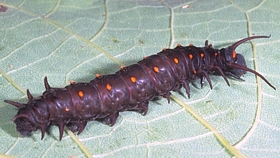 Pipevine Swallowtail Caterpillar (R. Bessin, 2001)
Pipevine Swallowtail Caterpillar (R. Bessin, 2001) |
|
| SIZE:
Adult wingspan up to 5 1/2", caterpillar up to 3" |
| |
| LIFE
CYCLE |
|
As
with all butterflies, swallowtails have complete metamorphosis with
egg, larval, pupal, and adult stages. Adults and caterpillars
are active in warm months. Most species overwinter as pupae. |
| ECOLOGY |
|
Many swallowtail adults
and caterpillars are common in feilds, meadows, and other weedy
areas. Others are common in wooded areas. Swallowtail
caterpillars feed on a variety of wildflowers and plants, depending
on the species. The adult butterflies feed only on nectar.
Swallowtail caterpillars
use a variety of defenses to protect themselves from predators.
As mentioned above, swallowtail caterpillars are able to secrete
chemicals from their osemetaria. These chemicals smell and
taste bad, and deter most predators. In addition, some swallowtail
caterpillars, such as the spicebush swallowtail, resemble snake
heads. It is believed that this resemblance will frighten
away birds and other large predators. Also, like most caterpillars,
swallowtail caterpillars will sometimes "let go" of their
perch and fall to the ground when they are disturbed. Even
though they have lots of defenses, swallowtail caterpillars are
attacked by a wide variety of predators, including birds, spiders,
and other insects. Adult swallowtails are preyed upon by birds
and flying insect predators, such as dragonflies and robber flies.
|
| |
| PEST
STATUS |
|
Swallowtails
are not normally considered pests, although a few species feed on
the foliage of garden plants. |
| |
| COMMON
KENTUCKY SWALLOWTAILS |
|
|
SPICEBUSH
SWALLOWTAIL
GENUS and SPECIES:
Papilio troilus
Pictured below right is
the Spicebush Swallowtail, Papilio troilus.
It is one of the most common woodland butterflies seen in
Kentucky. The caterpillar (below left) feeds on spicebush,
sassafras, and other low-growing forest plants. As mentioned
above, the caterpillar of the Spicebush Swallowtail resembles the
head of a snake. Its osmeterium even looks like a red, forked
tongue, helping to complete the illusion.
|
| |
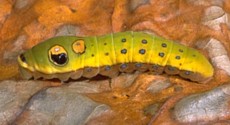 Spicebush Butterfly
Caterpillar
Spicebush Butterfly
Caterpillar
(R. Bessin, 2001) |
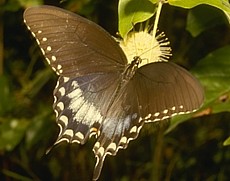 Spicebush Butterfly
Spicebush Butterfly
(Corel Photo CD, 1993) |
|
|
|
BLACK
SWALLOWTAIL
GENUS and SPECIES:
Papilio polyxenes
Shown below right is the
Black Swallowtail, Papilio polyxenes,
another common Kentucky swallowtail. This butterfly is often
found in open fields. The Black Swallowtail is one of the
few pest butterflies: its caterpillar (below left) sometimes feeds
on parsley, carrots, and related garden plants. It also feeds
on the wild relatives of these plants. |
| |
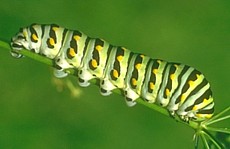 Black Swallowtail
Caterpillar
Black Swallowtail
Caterpillar
(R. Bessin, 2001) |
 Black Swallowtail
Black Swallowtail
(Corel Photo CD, 1993) |
|
|
|
EASTERN
TIGER SWALLOWTAIL
GENUS and SPECIES:
Papilio glaucus
One of our most recognizeable
swallowtails is the Eastern Tiger Swallowtail,
Papilio glaucus. This butterfly is very common, and
at certain times of the year Eastern Tiger Swallowtails can be seen
by the hundreds in eastern Kentucky forests. The Eastern Tiger
Swallowtail is shown below left. Below right, several tiger
swallowtails have gathered at a puddle. This is a common site:
butterflies of many species often visit muddy water to gather moisture
and nutrients, a behavior called "puddling." The
caterpillar of the Eastern Tiger Swallowtail is very similar to
the Spicebush Swallowtail caterpillar, with a snake-like appearance.
It feeds on the leaves of certain hardwood trees, such as
tulip trees, ash, birch, and cherry. You can see a picture
of it here
on the Caterpillars of Eastern Forests website. |
| |
 Eastern Tiger Swallowtail
Eastern Tiger Swallowtail
(Corel Photo CD, 1993) |
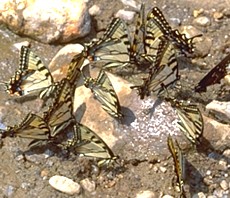 "Puddling" Eastern Tiger Swallowtails
"Puddling" Eastern Tiger Swallowtails
(R. Bessin, 2002) |
|
|
|
ZEBRA
SWALLOWTAIL
GENUS and SPECIES:
Graphium marcellus
Shown below is the Zebra
Swallowtail, Graphium marcellus. Like the
Eastern tiger Swallowtail, tthe Zebra is common in wooded areas.
The Zebra Swallowtail caterpillar feeds on pawpaw leaves,
and resembles the Black Swallowtail caterpillar, but with many narrow
yellow and green rings. It is pictured here
on the Caterpillars of Eastern Forests website. |
| |
 Zebra Swallowtail (B. Newton, 2003)
Zebra Swallowtail (B. Newton, 2003) |
|
| |
| COLLECTING
& PHOTOGRAPHY |
|
Swallowtails are common
butterflies, and are found in a variety of habitats. Eastern
Tiger Swallowtails and Spicebush Swallowtails can almost always
be found in Kentucky forests during the spring and summer, while
many other swallowtails are common in meadows, on farmland, and
near the forest edge. Swallowtails usually have a slow, lazy
flight compared to other butterflies, and are easy to catch with
a butterfly net.
Once captured, it is
best to keep any butterfly in a "butterfly envelope".
Visit this page to learn how to make your own butterfly envelopes:
http://www.kellscraft.com/butterfly01.html#COLLECTIONS
Swallowtails are popular
photography subjects, but getting a good picture can be a challenge
- even when a swallowtail isn't flying, it is usually walking or
moving its wings up and down. As with all insects, if you
find a swallowtail on a cool summer morning, it will be moving slowly
and will make a much better photo subject.
Swallowtail caterpillars
are slow moving and easy to capture, and can be found on a variety
of plants, depending on the species. All insect larvae should
be preserved in alcohol. You can also raise a swallowtail
caterpillar, but remember that it will be very picky: be sure to
identify it correctly and give it the right kind of food. Also,
since most swallowtails spend the winter as pupae, if a swallowtail
caterpillar that you raise turns in to a pupae, it is important
to keep it outside, or in another cool location, for the winter. |
| |
| MYTHS
- LEGENDS - FOLKLORE |
|
Swallowtails were sometimes
used to represent the images of certain Mexican mythical figures.
Read more about these images in Butterfly
Images in Mexican Myth and Textiles at the North American Butterfly Association website.
|
| |
Original document: 25 May 2004
Last updated: 25 May 2004
Spicebush and Black
Swallowtail photos courtesy Corel, 1993. Used with permission. Other
photos courtesy R. Bessin and B. Newton, University of Kentucky
The Kentucky Critter Files are maintained by Blake Newton, Department
of Entomology, University of Kentucky.
Contact: blaken@uky.edu |
|

